What is Marine Paint Used for?
What is Marine Paint Used for?
Marine Paint and coatingsare used interchangeably and they are a type of protective coating used mostly in the marine environment to protect ships, vessels, tankers, and other materials from saline water or freshwater. A marine coating has specific functional properties; therefore, it can provide superior protection to the surfaces to which it is applied. This coating protects submerged materials as well as vessels, ships, or yachts from seawater.
Marine coatings protect materials from corrosion and abrasion. The world marine coatings market was forecasted to be US$11.88 billion by 2020.
Transportation of goods by sea has historically been the most widely used form of shipping throughout human history. In comparison to air shipping speed, sea transportation remains the preferred method for larger, heavier cars. It is also less expensive, less taxing on the environment, and virtually no restrictions on destinations. In short, it is nothing less than a driving force behind a functional global economy.
Keeping ships efficient is no small task. Coatings designed for this market are specifically formulated to ensure smooth sailing and, as such, are used for anti-fouling, anti-corrosion, and self-cleaning purposes.
Acording to reports from from coatings world “Anti-corrosion coatings are majorly applied during new shipbuilding activities,” the report stated. “These coatings offer protection to the surface from abrasion, corrosion and impact. Foul-release coating is one of the popular marine coatings in the maritime industry. Foul-release coatings are biocide-free and environmentally compatible. Demand for other marine coatings such as self-cleaning and self-polishing coatings is likely to be stable through 2020.”
High demand for marine coatings in Asia Pacific, especially due to the emergence of China as a major player in the shipbuilding industry, is driving the marine coatings market in the region, according to the report. “The need for fuel-saving and low-emission coatings are factors driving the growth of the marine coatings market over the past few years. Growth in the shipbuilding industry in India, Vietnam and the Philippines is expected to provide large opportunities for players in the marine coatings market during the forecast period. However, volatility in prices of raw materials is projected to hamper market growth during the same period.”
Suppliers report that the marine coatings market saw a slight decrease over the last 12 months, though there is reason to believe the market will continue to stabilize and remain strong.
Jotun Marine Paint AlkydPrimer
What are marine paint and coatings?
Marine paint and coatings are always used interchangeably. Marine paint and coatings are waterproof, protective layers that are applied to surfaces exposed to or immersed in fresh, brackish, and saltwater. They are used with boats, ships, yachts, ferries, and other watercraft and marine platforms such as offshore oil rigs.
Marine coatings are a type of protective coating used mostly in the marine environment to protect ships, vessels, tankers, and other materials from saline water or fresh water. A marine coating has specific functional properties, therefore it can provide superior protection to the surfaces to which it is applied. This coating protects submerged materials as well as vessels, ships, or yachts from sea water.
Marine coatings protect materials from corrosion and abrasion. The world marine coatings market was forecasted to be US$11.88 billion by 2020
The application of marine coatings is quite a plethora, but we will mention a few that are majorly applied.
Marine paints' best us are for watercraft, which are exposed and immersed into saltwater or freshwater. They are waterproof paints and act as a protective layer to the submerged materials. Other uses of marine paints are in ships, boats, ferries, yachts, submarines, etc. Marine paint is used for houses, like hardwood floors, house furniture, and other exterior surfaces
International Paint Interbond 201 20L
Application of marine paint and Coatings
Marine coatings are primarily used in protecting the parts of marine vessels from corrosion and fouling. The coating system applied to any part of a ship will depend on the environment to which the part of the ship is exposed. Traditionally the painting of the external ship structure was divided into three regions.
- Below the water-line
Here is where the plates are continually immersed in seawater. The ship's bottom has priming coats of corrosion inhibiting paint applied, which are followed by an anti-fouling paint. Paints used for steels immersed in seawater are required to resist alkaline conditions. The reason for this is that an iron alloy immersed in a sodium chloride solution having the necessary supply of dissolved oxygen gives rise to corrosion cells with caustic soda produced at the cathodes. The paint should have good electrical resistance so that the flow of corrosion currents between the steel and seawater is limited. These requirements make the standard non-marine structural steel primer red lead in linseed oil unsuitable for ship use below the water-line. Suitable corrosion-inhibiting paints for ships' bottoms are pitch or bitumen types, chlorinated rubber, coal tar/ epoxy resin, or vinyl resin paints. The anti-fouling paints may be applied after the corrosion-inhibiting coatings and should not directly contact the steel hull, since the toxic compounds present may cause corrosion.
2. The water-line or boot topping region
Here is where immersion is intermittent, and a lot of abrasions occur. Generally, the modern practice requires a complete paint system for the hull above the water-line. This may be based on vinyl and alkyd resins or on polyurethane resin paints.
3. The topsides and superstructure
Exposed parts of ships to the atmosphere are often laden with salt spray and subject to damage through cargo handling. Red lead or zinc chromate based primers are commonly used on superstructures. White finishing paints are then used extensively for superstructures. These are usually oleo-resinous or alkyd paints, which may be based on 'non yellowing' oils, linseed oil-based paints which yellow on exposure being avoided on modern ships.
Where aluminum superstructures are fitted, under no circumstance should lead-based paints be applied; zinc chromate paints are supplied for application to aluminum.
Jotun marine paint hardtop clear AS
Temporal coating application for shipbuilding
After the steel is blast cleaned, it may be several months before it is built into the ship and finally painted. It is desirable to protect the material against rusting in this period as the final paint will offer the best protection when applied over perfectly clean steel.
The formulation of a prefabrication primer for immediate application after blasting must meet several requirements. It should dry rapidly to permit the handling of the plates within a few minutes. It should be non-toxic and should not produce harmful porosity in welds nor give off obnoxious fumes during welding or cutting. It must also be compatible with any subsequent paint finishes being applied. Suitable formulations are available, for example, a primer consisting of zinc dust in an epoxy resin.
Good surface preparation is a prerequisite for a successful painting, the primary cause of many paint failures being the inadequacy of the initial material preparation. It is particularly essential before painting new steel that any mill scale should be removed. Mill Scale is a thin layer of iron oxides that form on the steel surface during the plates and sections' hot rolling. Not only does the non-uniform mill scale set up corrosion cells as illustrated previously, but it may also come away from the surface, removing any paint film applied over it.
Sigmaguard 720 Marine paint
Marine paint and Coatings Hazards
Marine Paint may contain toxic or irritant substances, and the solvents may give rise to flammable and potentially explosive vapors, which may also be toxic to our health. Personnel using such paints should be warned of the particular risks arising from their use. Paints containing organic pesticides can be particularly dangerous. Suppose the manufacturer's instructions are not given on the container. In that case, information should be obtained at the time of supply about any specific or general hazards concerning the product and also whether special methods of application should be followed. Such advice should be readily available at the time of use, but the following precautions should always adhere.
Protecting ships with suitable marine coatings can be tedious and complicated. For more assistance, information, consultation, training, and procurement, contact us.
Frequently Asked Questions
1. How long does marine paint take to dry?
Drying times can vary depending on the type of paint, environmental conditions, and the thickness of the applied coat. Typically, marine paint may take a few hours to dry to touch, but it may take several days for a full cure. Refer to the paint manufacturer's guidelines for specific drying times.
2. How can I maintain the painted surfaces on my boat?
Regular maintenance is crucial to extend the life of the painted surfaces on your boat. This includes cleaning the surface regularly, avoiding harsh chemicals or abrasive materials, addressing any damage or scratches promptly, and applying touch-ups or recoating as necessary.
3. Can I use marine paint for non-marine applications?
Marine paint is specifically designed for marine environments and may not be suitable for non-marine applications. However, some marine paints can be used for other applications such as outdoor furniture or metal structures, depending on the specific product and manufacturer's recommendations.
Related Articles.
IS ALL MARINE PAINT OIL BASED?
Recent Posts
-
How to Choose the Right Industrial Cleaning Service Provider
Key takeawayThoroughly Assess Your Needs and Providers: Understand your specific industrial cle …Jul 26, 2024 -
Floor Paint Maintenance: How to Keep Your Floors Looking Their Best
Maintaining your painted floors is essential for preserving their beauty and extending their lifespa …Jul 25, 2024 -
The Best Floor Paint for Different Types of Flooring
When it comes to revitalizing your home's flooring, choosing the right paint can make all the d …Jul 19, 2024






